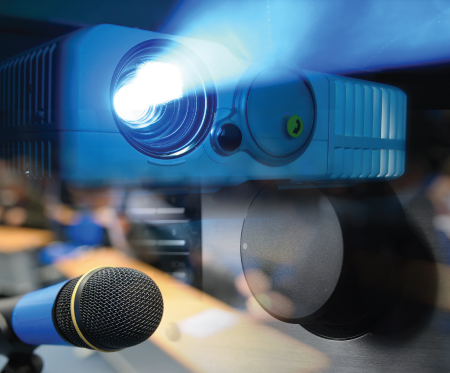How audio visual charlotte nc transforms venue lighting for maximum impact
Comprehending the Incorporation of Audio Visual Innovation in Today's Educational Environments
The assimilation of audio-visual technology in academic settings has changed the training and discovering procedure. Educators currently have accessibility to tools that satisfy various finding out designs, improving trainee interaction and collaboration. Nonetheless, the unification of these modern technologies offers both possibilities and obstacles. Comprehending just how to successfully execute these tools is important. What strategies can instructors employ to take full advantage of the advantages of audio-visual innovation in their classrooms?
The Development of Audio-Visual Technology in Education And Learning
As instructional needs advanced over the decades, audio-visual technology went through substantial improvements that improved the knowing setting. Tools such as movie projectors and slide programs were the main methods of incorporating aesthetic aspects right into class. These very early innovations offered instructors with the capacity to present info dynamically, yet they were restricted in availability and interactivity.
With the advent of video cassette recorders in the 1970s, classrooms started to incorporate documented lessons, expanding the scope of academic resources. The introduction of individual computers in the 1980s further changed this landscape, enabling the creation of multimedia presentations and interactive learning experiences.
The surge of the net in the 1990s noted a crucial minute, making it possible for real-time accessibility to a riches of audio-visual materials. Today, digital tools such as interactive whiteboards and on the internet learning platforms remain to enhance the instructional experience, fostering engagement and partnership amongst learners.
Benefits of Audio-Visual Equipment for Diverse Understanding Styles
Audio-visual devices play a necessary role in catering to varied discovering styles by boosting visual understanding and improving auditory engagement. By integrating images, video clips, and sound, these modern technologies develop an even more comprehensive instructional setting. This diverse strategy allows instructors to deal with the varied preferences and needs of pupils efficiently.
Enhancing Visual Learning
Involvement in the discovering process is significantly enhanced with using audio-visual devices, satisfying different discovering styles. These devices, such as videos, infographics, and interactive presentations, give visual stimulations that help comprehension and retention. Aesthetic learners, particularly, gain from the consolidation of images and computer animations, which can streamline complex ideas and improve understanding. In addition, audio-visual sources can show real-world applications, making finding out more appropriate and interesting. By incorporating shade, movement, and noise, instructors can create a dynamic learning atmosphere that captures trainees' focus and promotes much deeper cognitive links. Eventually, the strategic use audio-visual technology not only sustains visual learning but also enhances the total educational experience for varied students.
Improving Auditory Engagement
A substantial benefit of integrating audio-visual devices in education is their capability to boost acoustic engagement among students. These devices, which include multimedia presentations, podcasts, and interactive audio components, deal with numerous discovering designs, especially profiting acoustic students (audio visual charlotte nc). By integrating noise and narration, educators can produce immersive experiences that capture trainees' interest and enhance comprehension. This engagement is crucial, as it fosters a deeper understanding of the material and advertises retention. Additionally, audio-visual tools can facilitate collaborative learning environments, urging pupils to join discussions and share their insights. Eventually, the incorporation of audio-visual technology not just sustains auditory engagement yet likewise enriches the total instructional experience, making discovering more vibrant and effective for all trainees
Enhancing Interaction Via Interactive Learning

Moreover, gamification components, such as quizzes and simulations, can enhance inspiration and retention, making learning a lot more pleasurable and effective. These approaches not only stimulate cognitive interaction but additionally accommodate varied learning styles, making sure that all trainees can participate meaningfully. Because of this, interactive discovering settings foster a sense of neighborhood and belonging, inevitably resulting in boosted academic end results. Via the integration of audio aesthetic modern technology, educators can transform typical classrooms into dynamic areas where trainees prosper and proactively form their academic journeys.
Connecting Concept and Exercise With Multimedia Resources
Multimedia resources act as a crucial link between theoretical ideas and sensible application in educational settings. By improving interaction, promoting joint learning experiences, and supporting diverse knowing styles, these tools create a much more inclusive and dynamic knowing environment - audio visual charlotte nc. This strategy not only fosters much deeper understanding but also prepares trainees for real-world obstacles

Enhancing Engagement Via Multimedia
Involvement in academic settings substantially enhances when trainers integrate multimedia sources into their mentor methods. The usage of video clips, podcasts, and interactive discussions improves the learning audio visual charlotte nc experience, permitting pupils to attach with the product on multiple degrees. Multimedia resources cater to various learning styles, providing aesthetic, acoustic, and kinesthetic stimuli that can hold pupils' attention more effectively than standard lecture methods. In addition, these resources can simplify complex concepts, making them a lot more available and memorable. By incorporating multimedia, instructors can produce a dynamic class environment that promotes interest and inspires learners. Inevitably, the critical usage of audio-visual innovation offers to connect the space between academic expertise and practical application, improving the instructional experience for both trainers and students.
Helping With Collaborative Discovering Experiences
Numerous research studies show that collaborative discovering experiences significantly boost student results when incorporated with multimedia resources. Multimedia tools assist in communication amongst students, allowing them to engage in analytical and essential believing jointly. By making use of video conferencing, collective systems, and interactive discussions, educators produce settings helpful to teamwork and shared knowing. These technologies enable trainees to communicate their concepts effectively and get immediate comments, promoting a much deeper understanding of the subject issue. In addition, multimedia resources can present complex concepts in more digestible formats, promoting discussion and collaboration. Consequently, the mix of collaborative knowing and audio-visual modern technology not just improves the instructional experience yet additionally prepares pupils for real-world synergy characteristics, highlighting the importance of teamwork and cumulative understanding building.
Supporting Diverse Knowing Styles
While conventional teaching methods usually accommodate a restricted series of discovering choices, the combination of audio-visual innovation uses an extra comprehensive strategy to education and learning. By using multimedia sources such as videos, interactive simulations, and digital discussions, teachers can address various finding out styles, consisting of aesthetic, acoustic, and kinesthetic. This versatility allows for separated guideline, enabling trainees to engage with content in manner ins which reverberate with their specific preferences. Additionally, audio-visual devices can help with much deeper understanding by supplying multiple depictions of complex ideas. Because of this, trainees who might have problem with standard methods can locate alternative paths to success, cultivating an extra equitable learning environment that supports scholastic achievement for all learners.
Challenges in Executing Audio-Visual Innovation
Audio-visual technology holds great pledge for enhancing academic experiences, its implementation frequently encounters considerable challenges. One main concern is the economic problem connected with purchasing and preserving such equipment, which can stress budgets, particularly in underfunded establishments. Additionally, inadequate training for teachers can impede reliable assimilation, leaving them ill-prepared to utilize the modern technology fully. Technical issues, such as software application malfunctions and compatibility issues, may likewise interfere with lessons and annoy both teachers and trainees. Varying levels of student accessibility to modern technology outside the class can develop variations in learning opportunities. The capacity for over-reliance on innovation might take away from crucial training approaches, inevitably limiting the instructional experience. Dealing with these difficulties requires an extensive technique, including adequate financing, expert advancement, and equitable accessibility to sources, to assure that audio-visual technology can be leveraged properly in today's academic settings.
Best Practices for Integrating Innovation in the Class

In addition, promoting an interactive environment with collaborative tools urges pupil engagement and involvement. Making use of diverse audio-visual sources accommodates various finding out designs, suiting visual, auditory, and kinesthetic students. Frequently examining the impact of technology on student discovering helps teachers improve their techniques and adjust to altering needs. Lastly, entailing students in the option of technology promotes possession and inspiration. By sticking to these finest techniques, instructors can produce a dynamic class ambience that effectively integrates modern technology and improves the instructional experience for all trainees.
The Future of Audio-Visual Innovation in Education
As classrooms progressively embrace modern technology, the landscape of audio-visual devices in education and learning remains to develop (audio visual charlotte nc). Future advancements are expected to focus on greater interactivity and personalization, allowing instructors to tailor learning experiences to specific student needs. Technologies such as enhanced truth (AR) and virtual reality (VIRTUAL REALITY) will likely provide immersive knowing atmospheres, enhancing student involvement and understanding
Furthermore, fabricated intelligence (AI) is poised to play a significant duty in audio-visual technology by providing real-time comments and flexible understanding pathways. This combination may help teachers recognize and attend to pupil difficulties better. Cloud-based platforms will assist in simpler accessibility to resources and collaboration amongst pupils and instructors, regardless of place.
Along with these technological advances, professional development for teachers will be vital, guaranteeing they are outfitted to make use of these devices effectively. Overall, the future of audio-visual modern technology in education and learning assures to develop more dynamic, inclusive, and impactful learning experiences.
Frequently Asked Questions
How Can Educators Choose the Right Audio-Visual Equipment for Their Class?
Selecting proper audio-visual tools needs teachers to analyze their instructional objectives, think about trainee demands, evaluate readily available modern technology, and seek recommendations from peers or specialists, ensuring tools successfully improve understanding and engagement within their certain classroom atmosphere.
What Budget plan Factors to consider Are There for Applying Audio-Visual Innovation?
Budget plan factors to consider for carrying out audio-visual modern technology consist of initial acquisition prices, maintenance expenses, training for personnel, and prospective software program licensing fees. Additionally, lasting financial investment in updates and replacements should additionally be factored right into financial planning.
Are There Specific Training Resources for Educators on Audio-Visual Tools?
Many establishments provide training resources for instructors on audio-visual devices, including on the internet courses, workshops, and training overviews. These sources intend to enhance instructors' abilities and confidence in effectively incorporating modern technology right into their teaching practices.
How Do We Gauge the Efficiency of Audio-Visual Modern Technology in Learning?
Measuring the performance of audio-visual technology in finding out entails evaluating pupil interaction, understanding, retention prices, and total academic performance. Studies, evaluations, and empirical researches can give beneficial understandings right into its effect on instructional outcomes.
What Prevail Misunderstandings Regarding Audio-Visual Technology in Education?
Usual mistaken beliefs regarding audio-visual modern technology in education include the idea that it ensures interaction and discovering results, in addition to the assumption that all pupils profit equally, ignoring private discovering choices and needs.